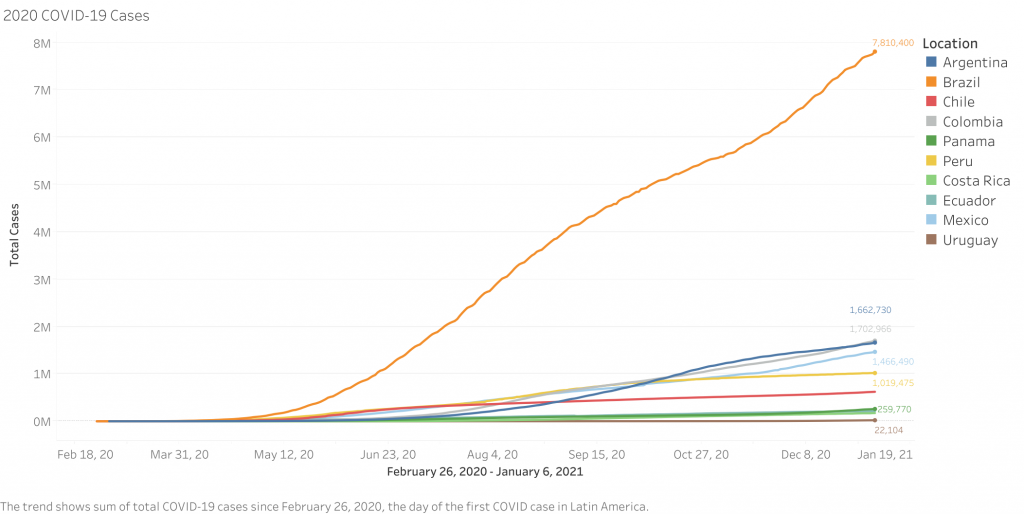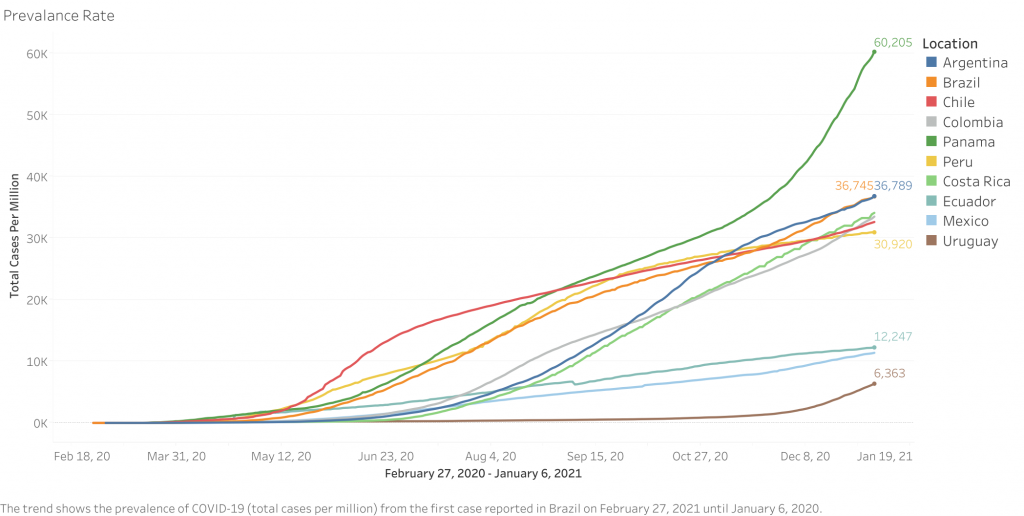What you should know
- US Capitol Insurrection: Regional heads of state, including Argentina, Chile, Colombia, and Ecuador, took to Twitter to condemn the violence unleashed in Washington DC.
- Vaccine Race: Mexico, Chile, Costa Rica, and Argentina are the first countries in Latin America and the Caribbean to begin COVID-19 vaccinations.
- 2021 Forecast: According to the Economic Commission on Latin America and the Caribbean, the region contracted 7.7 percent in 2020. Regional growth for 2021 – forecast at 3.7 percent – will be insufficient to recover pre-COVID economic activity levels seen in 2019.
- A Digital Transformation Underway: The Pan American Health Organization (PAHO) and representatives of the Health Commissions of the Parliaments of the Americas committed to enact laws to accelerate the digital transformation of the health sector.
- 21.6 billion: The Inter-American Development Bank approved a record-breaking $21.6 billion in financing in 2020 to help its 26 member countries navigate the crisis. Here are this week’s figures.
Health + Innovation
- On January 7, São Paulo-based research center Butantan Institute announced late-stage trials of China’s Sinovac vaccine showed 78 percent efficacy. Butantan has requested federal health regulator Anvisa for emergency use authorization for the vaccine.
- On January 5, Bolivia granted emergency approval to Russia’s Sputnik V vaccine, and El Salvador authorized use of the AstraZeneca-Oxford vaccine.
- On January 5, Mexico received its first shipment of the Pfizer-BioNTech vaccine of the year — and fourth overall — containing over 50,000 doses. Mexico began vaccinating its healthcare personnel on December 24, becoming the first Latin American country to do so. The government is expecting to receive 1.4 million doses by the end of January, enough to vaccinate most of the country’s 750,000 health care workers. On January 4, Mexico approved the Oxford-AstraZeneca COVID-19 vaccine for emergency use.
- On January 4, Colombia authorized emergency use of the Pfizer-BioNTech vaccine. Colombia will purchase 10 million doses of the vaccine.
- On January 3, Brazilian regulatory agency Anvisa approved the import of 2 million doses of the AstraZeneca-Oxford vaccine, although the vaccine itself has not yet been approved for use in the country.
- Chile began vaccinating on December 24 with the Pfizer-BioNTech vaccine. The country has supply agreements for 10 million vaccine doses with Pfizer-BioNTech, 10 million with Sinovac, and it has also signed agreements with AtraZeneca and Janssen.
- Also on December 24, Costa Rica began administering the Pfizer-BioNTech vaccine. The country has an agreement to purchase 3 million doses from Pfizer.
- On December 30, Argentina began its inoculation plan with the Russian Sputnik V vaccine. Argentina has also granted emergency approval to the Pfizer-BioNTech and AstraZeneca-Oxford vaccines.
Economies in focus
Economic Impact
- The World Bank expects the global economy to expand 4 percent in 2021, assuming a COVID-19 vaccine becomes widely available this year. However, if infections continue to rise and vaccine rollout is delayed, global GDP growth could be limited to 1.6 percent.
- Belize is expected to have the highest GDP growth in Central America in 2021, with its GDP forecast to grow 6.9 percent, followed by Panama and El Salvador with 5.1 percent and 4.6 percent respectively.
- New figures show Brazil had a $51 billion trade surplus in 2020, a 6 percent increase over 2019, as the pandemic impacted imports more than exports.
- The Chilean economy grew by 0.3 percent in November 2020. Despite the small margin, it is the first increase in GDP since the pandemic began in March 2020.
Economic Aid Programs
- The IDB approved a $30 million loan to support micro, small, and medium-sized enterprises in Barbados, which comprise 96 percent of formal opportunities in the country.
- The IDB also approved a $100 million project to support the resilience of the southern region of Brazil in its COVID-19 recovery phase.
- The World Bank approved a $150 million project to support Honduras’ emergency response and recovery needs after hurricanes Eta and Iota.
- The IMF authorized a $2 billion loan to Ecuador as part of an aid plan that totals $6.5 billion and extends over 27 months.
Quarantine + Travel Restrictions
Quarantine and Reopening Plans
- Mexico began the new year with four states classified as red (maximum risk) per the nation’s four-colored traffic light system, including Guanajuato and Morelos which re-imposed strict public health measures. Twenty-two states are classified as orange (high risk), three states are classified as yellow (medium risk), and two states are classified as green (low risk).
- The Panamanian government announced new quarantine measures for the provinces of Panamá and Panamá Oeste. Movement restrictions in place until January 14 allow residents to conduct essential activities based on their identification number. The measure affects 2.2 million people.
- On January 5, three districts in Bogotá (Suba, Engativá, and Usaquén) entered a two-week quarantine. The three neighborhoods have the highest number of cases and contagion rates in the city. All non-essential activities are suspended and only one family member at a time may leave their residence for essential purposes.
- On January 4, restaurants in Grenada were permitted to resume dine-in services, although the nightly curfew from 8:00 p.m. to 5:00 a.m. will remain in effect until January 11.
International Travel Restrictions
- Argentina, Colombia, Chile, El Salvador, Grenada, Jamaica, and Peru canceled flights to and from the United Kingdom citing fears of a new, more contagious strain of the COVID-19 virus. The strain has also been found in Colorado, California, Florida, and New York but no restrictions on flights from the US have been announced.
- Uruguay’s borders have remained closed to residents and visitors alike since December 21 as the country experiences its first major wave of COVID-19 cases.
- After a court battle, Colombia will require travelers, including babies, to present a negative PCR test taken within 96 hours before their flight to enter Colombia. Brazil, Cuba, and Chile also require all visitors, citizens, and residents to present a negative PCR test taken no more than 72 hours before their flight.
In Focus: COVAX
As countries in the region begin rolling out COVID-19 vaccines, we analyze when vaccines might become available to lesser developed nations.
- UNICEF is currently working on a plan to procure and deliver vaccines for 92 lower and lower-middle-income countries (including Bolivia, Dominica, El Salvador, Granada, Guyana, Haiti, Honduras, Nicaragua, St. Lucia, and St. Vincent and the Grenadines) on behalf of the purchasing group. UNICEF is also seeking to double its capacity to transport up to 850 tons of COVID-19 vaccines per month in 2021.
- The COVAX Facility has hedged its bets to secure an effective COVID-19 vaccine, negotiating purchasing agreements with several vaccine candidates on behalf of participating countries. The Facility has agreements with AstraZeneca/Oxford, the Serum Institute of India, Johnson & Johnson, and Sanofi/GSK, although the WHO has yet to approve any of these vaccines for use. PAHO said all Latin American and Caribbean countries will receive the COVAX vaccines at the same time, regardless if they purchased them full-price or with COVAX´s financial assistance.
- While COVAX aims to distribute 2 billion vaccines in 2021, the World Health Organization realistically expects 65 million vaccines will be distributed during the first trimester of 2021, with vaccinations beginning in March. To make matters worse, COVAX has failed to raise enough funding, potentially complicating its goal to reach 20 percent of member countries’ populations by 2021.
By the numbers
- Cases by country: Brazil (7,812,007) #3 worldwide, Colombia (1,702,966) #11 worldwide, Argentina (1,662,730) #12 worldwide, Mexico (1,466,490) #13 worldwide, Peru (1,021,058) #18 worldwide, Chile (623,101) #24 worldwide, Panama (259,770) #41 worldwide, Ecuador (216,083) #46 worldwide, Dominican Republic (175,849) #52 worldwide, Costa Rica (173,591) #53 worldwide, Source: worldometers.info
- Prevalence rate (total cases per million people): Panama (59,724) #10 worldwide, Aruba (53,421) #18 worldwide, Brazil (36,618) #32 worldwide, Argentina (36,617) #33 worldwide, Costa Rica (33,918) #42 worldwide, Colombia (33,286) #45 worldwide, Chile (32,452) #46 worldwide, Peru (30,748) #47 worldwide, Belize (27,455) #54 worldwide, Saint Martin (25,511) #58 worldwide, Source: worldometers.info
- Deaths per capita (deaths per million people): Peru (1,141) #10 worldwide, Mexico (994) #19 worldwide, Panama (974) #20 worldwide, Brazil (927) #23 worldwide, Chile (874) #26 worldwide, Colombia (868) #27 worldwide, Ecuador (793) #30 worldwide, Bolivia (786) #31 worldwide, Belize (643) #40 worldwide, Aruba (467) #46 worldwide, Source: worldometers.info
Quick take


